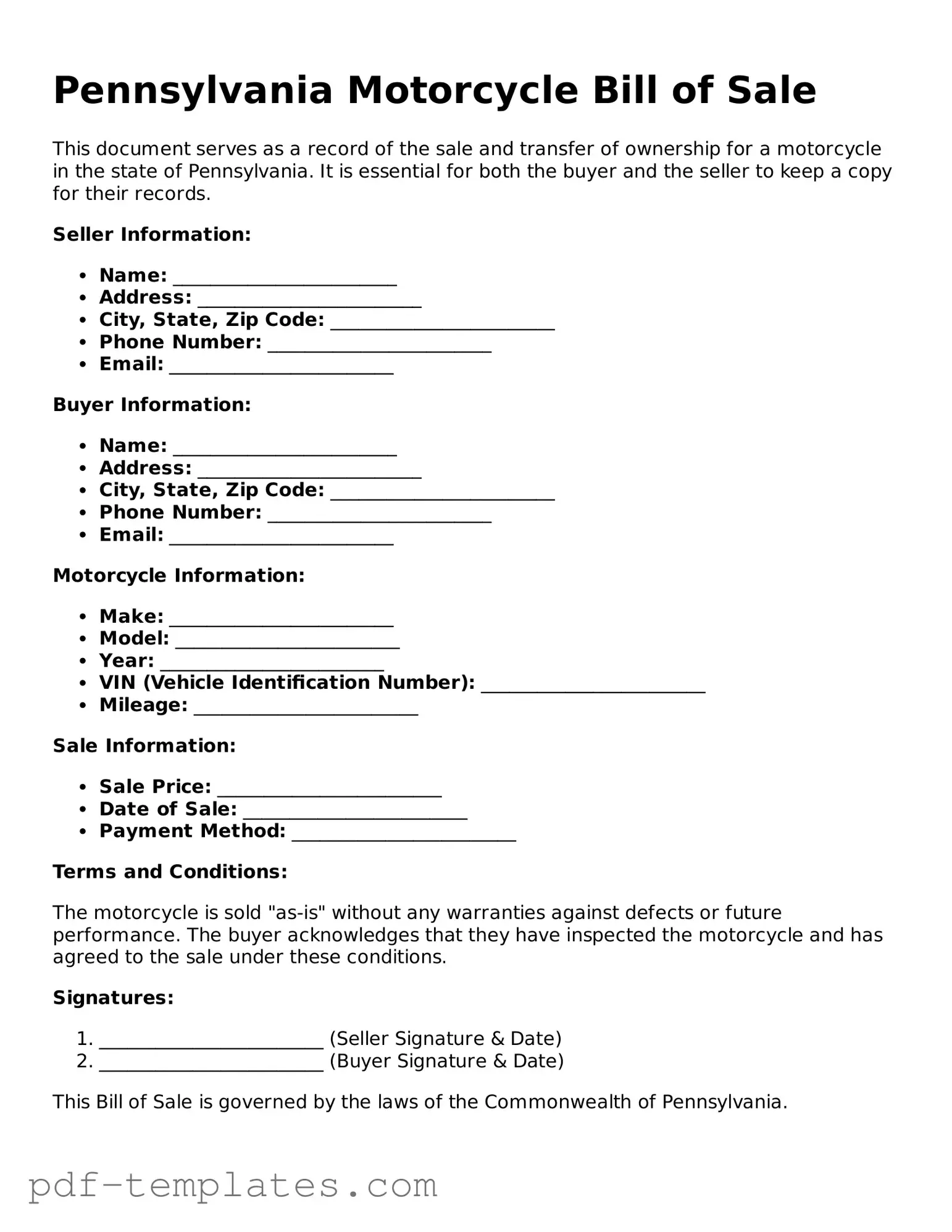The Pennsylvania Vehicle Bill of Sale is a document that serves as proof of the sale of a vehicle, including motorcycles. Similar to the Motorcycle Bill of Sale, this document records essential details such as the buyer's and seller's names, vehicle identification number (VIN), and the sale price. It provides legal protection for both parties involved in the transaction, ensuring that ownership is properly transferred and documented. This form is crucial for registering the vehicle with the state after the sale.
The Pennsylvania Boat Bill of Sale is another document that shares similarities with the Motorcycle Bill of Sale. Like the motorcycle form, it includes information about the buyer, seller, and the boat being sold. This document is essential for transferring ownership of a boat and can help prevent disputes regarding ownership in the future. Both forms serve as a legal record of the transaction, ensuring that all parties have a clear understanding of the sale's terms.
The Pennsylvania ATV Bill of Sale functions similarly to the Motorcycle Bill of Sale, as it documents the sale of an all-terrain vehicle. This form captures critical details such as the VIN, sale price, and the identities of both the buyer and seller. Just like the motorcycle bill of sale, this document is important for registering the ATV with the state and provides a safeguard against potential disputes over ownership.
The Pennsylvania Trailer Bill of Sale is another comparable document. This form is used when a trailer is sold and includes similar information to the Motorcycle Bill of Sale, such as the names of the parties involved, the trailer's identification number, and the sale price. The Trailer Bill of Sale serves to protect both the buyer and seller, ensuring that the transfer of ownership is documented and legally binding.
The Pennsylvania Car Title Transfer form is closely related to the Motorcycle Bill of Sale. While the Motorcycle Bill of Sale records the sale, the Title Transfer form specifically handles the legal transfer of ownership from the seller to the buyer. This document must be completed in conjunction with the bill of sale to ensure that the buyer can register the motorcycle in their name legally.
The Pennsylvania Firearm Bill of Sale is another document that bears resemblance to the Motorcycle Bill of Sale. This form records the sale of a firearm and includes details about the buyer, seller, and the firearm itself. Both documents serve to provide proof of the transaction and protect the rights of both parties involved. They help to establish a clear chain of ownership, which is crucial for legal compliance.
The Pennsylvania Lease Agreement is somewhat similar in that it outlines the terms of an agreement between two parties. While it is not a sale document, it does require clear identification of the parties involved, similar to the Motorcycle Bill of Sale. This agreement protects the rights of both the landlord and tenant, ensuring that all terms are understood and agreed upon, much like the motorcycle sale process.
The Pennsylvania Rental Agreement also shares characteristics with the Motorcycle Bill of Sale. This document details the terms under which a property is rented, including the responsibilities of both the landlord and tenant. While it is not a sale document, both agreements serve to protect the interests of the parties involved by clearly outlining the terms of the transaction.
The California Application Registered In-House Counsel form is an essential document for out-of-state attorneys aiming to practice as in-house counsel in California, ensuring they comply with state laws and regulations before taking on their professional roles. To understand more about the requirements for various legal forms, refer to All California Forms which provide comprehensive guidance for attorneys navigating the registration process.
Finally, the Pennsylvania Partnership Agreement is another document that, while not a sale document, establishes a formal relationship between parties. It includes details about the partners, their contributions, and the terms of the partnership. Like the Motorcycle Bill of Sale, it serves to clarify the roles and responsibilities of each party, ensuring that everyone is on the same page regarding their commitments and expectations.
